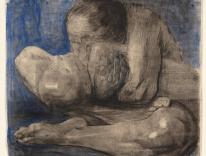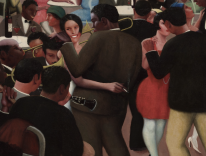Anita Berber is the star of the Metropolitan Museum of Art’s exhibition, “Glitter and Doom: German Portraits from the 1920s.” She certainly wasn’t beautiful. Like most of the paintings in the show, which closes February 19, her portrait is a caricature, designed to exaggerate her haggard boniness and pasty skin. The portrait is all white and red-bloodless, stage-makeup white for Berber’s skin, and drenching, garish red for her lips and dress. Her contorted face looks like something out of Nosferatu, or like the terrifying vision from Samuel Taylor Coleridge’s “The Rime of the Ancient Mariner”: “Her skin was as white as leprosy; / The Night-mare Life-in-Death was she.”
But then, nightmare was her shtick. Berber was a dancer; with her husband, she created and performed in shows with titles such as Suicide, Morphine, and Cocaine. Her career was based on the same impulse that animated most of the Met exhibit’s painters: the need to demonize and glamorize the same vices, the same decadence. And so this lurid portrait of a woman intentionally making herself repulsive can stand as the exemplary painting of the show: painful, cruel, and undeniably compelling.
The exhibit’s paintings are swollen with anger, contempt, and self-disgust. It’s one thing to lampoon one’s enemies, but one of the striking features of the Met show is how often the Weimar artists attacked their own, savagely caricaturing friends and patrons as mincing homosexuals or hook-nosed Shylocks. Even the self-portraits often suggest shame and revulsion.
There are a few signs of gentleness and beauty-for example, Otto Dix’s lovely sketch of his wife looking up at him from her pillow: a shy, dreamy sketch, all tenderness and sleepy flowing lines. It couldn’t be a sharper contrast to the other portrayals of sex in the exhibit-the vulture-faced transvestites and pornographically splayed nudes. (The show bears a warning to parents that some of its images are unsuitable for children.) One wall is dominated by Dix’s painting of the eccentric aristocrat and poet Iwar von Lucken, looking shab¬by and lost in a tiny attic room, while outside his window a swirling apocalyptic sky is pierced by a church-spire angel. Although Dix exaggerated von Lucken’s long nose and wistful expression, the portrait isn’t cruel; the El Greco sky suggests impending tragedy, but for once the painter really seems to respect his subject.
Rudolf Schlichter was another artist who clearly believed that his subjects were people. He was one of the rare defenders of “the workers” who actually seem to view the workers as individuals, rather than faceless masses or players in his own psychodrama. The Met features a naturalistic portrait of a tired prostitute with a resigned expression. Unlike the show’s other portraits of prostitutes, this one doesn’t rely on the lurid nature of its subject’s profession for its effect. In fact, Schlichter downplayed any hint of sexuality, portraying his subject in a long skirt and modest blouse. With her cigarette and exhausted expression, she looks like an overworked bureaucrat on a smoke break. Schlichter was able to make even a painting of a stranger suggest overlooked intelligence and kindness.
In both style and tone, this portrait is the exception. Although the artists were all part of a group dubbed “Verists” for their concern with real-world situations and social problems, few of the paintings are naturalistic. The show draws out the connection between the heightened-contrast, dreamlike Expressionist style of filmmaking-born in Germany during roughly the same period-and caricature. Many of the paintings seem caught somewhere between an Expressionist film and a political cartoon. Expressionism lent itself readily to horror films, and the Met exhibit soon begins to seem like a nightmare carnival filled with frightening stock characters like the profiteer and the sadist.
It is impossible-as the show’s title acknowledges-to view the paintings without looking for the shadow of Nazism. Many of the artists (and their subjects) fled to America. But their Weimar-era paintings show surprisingly few hints of what was to come. Those caricatured Jews and gay men seem especially vicious given the context. But overall, the painters showed far more political attention to their recent past than to their future. Many of the paintings deal with the legacy of World War I: angry depictions of disfigured veterans, or Otto Dix’s How I Looked as a Soldier, a self-portrait sketch showing the artist in his younger days as a grim-faced soldier clutching a huge gun. (The caption of Dix’s Widow notes that the subject might also have been a prostitute: after the Great War, the terms “widow” and “prostitute” were sometimes used interchangeably.)
If there is any hint of what lay ahead, it is perhaps the air of hopelessness that hangs over the paintings. Everything was corrupted, and so everything was rejected. There are almost no paintings showing a love of anything, not even beauty or art itself. The subject of Heinrich Maria Davringhausen’s The Profiteer seems trapped, sitting in a blank office surrounded by huge, menacing skyscrapers, his face anxiously outthrust.
Portraits, by their nature, have a tendency to trap their subjects. Unlike a photograph, which takes less time to create and almost always suggests life continuing outside the edges of the frame, a painted portrait can suggest that the subject held the same position, looked the same, was the same, for hours-and maybe forever. A painted portrait, far more than a photograph, typically suggests, “This is the way things are and the way they will always be.” The Weimar portraits in “Glitter and Doom” seem to trap the viewer as well. They are, almost without exception, brilliant: skillfully done, compelling, with a car-crash quality that makes them impossible to ignore. They are also hopeless.
One of the portraits shows the psychiatrist Heinrich Stadelmann looking like an asylum escapee. The caption notes that Stadelmann had also been a Dadaist, who, as his friend George Grosz put it, “considered Dada a kind of mental disease of society worth studying.” The disease whose symptoms are displayed in the Met show has a simpler name: nihilism.
Please email comments to [email protected] and join the conversation on our Facebook page.
Previous Story
The People's Court
Next Story
The Knock


